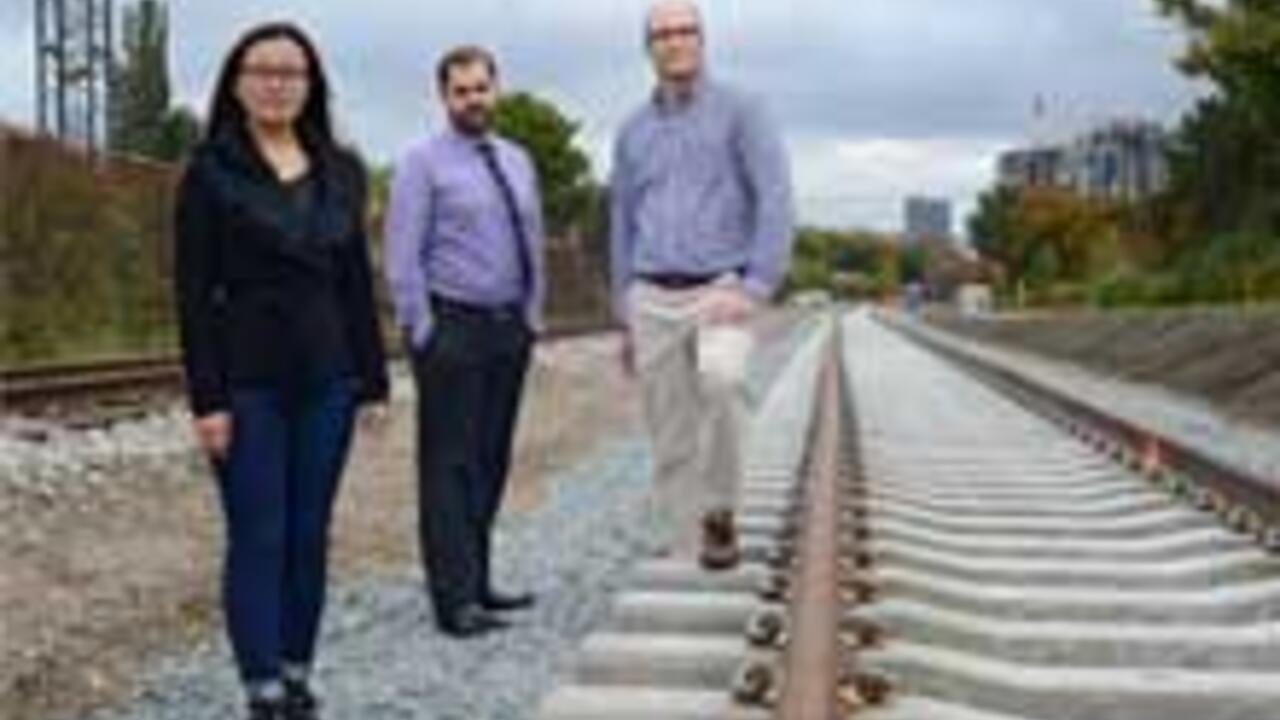
School of Planning helps shape Waterloo’s innovation ecosystem
Waterloo faculty, alumni and students advise on progressive urban planning to attract the world’s top talent

Waterloo faculty, alumni and students advise on progressive urban planning to attract the world’s top talent
By Sam Toman Faculty of EnvironmentThanks in part to the University of Waterloo and its entrepreneurial spirit, the Region of Waterloo is growing fast. Growth is great, but managing it takes careful planning to ensure its citizens are healthy, its economy vibrant and environment protected.
Having the University of Waterloo’s top-rated School of Planning is an often-overlooked ingredient in the recipe making the Region of Waterloo an economic success story and hotbed of innovation. Thanks to cutting-edge research and a pool of talented planning alumni coming out of the school, Waterloo Region is carving out a new identity as beacon of progressive urban planning, and a place capable of attracting top talent.
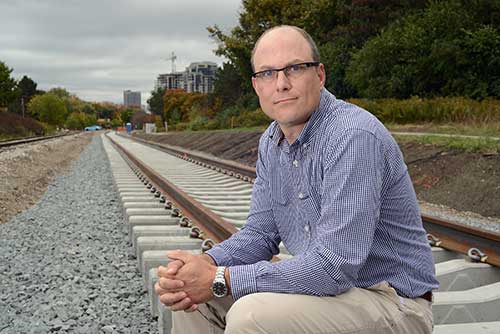
In 2004 when the Region of Waterloo was getting serious about building a light rail transit system (LRT) they reached out for advice to Vukan Vuchic, a leading international transportation planner. The best advice he could give them? Hire his former student, and newly minted Waterloo planning professor, Jeff Casello.
Today, Casello is jointly appointed to the School of Planning and the Department of Civil and Environmental Engineering and is regarded as one of Canada’s foremost experts in public transportation.
Since arriving in the area in 2004, he’s been a constant presence informing the Region’s light rail project and the innovative urban development strategy and advocating for light rail in the Record, The Agenda and in the National Post.
More importantly, Casello combines the world-renowned data-driven research power of the University of Waterloo with cutting-edge planning philosophy to chart a course for a prosperous path-breaking future for the Region.
“I think the Region of Waterloo is one of the first places in North America to actually put the transportation infrastructure in first, and try and use that to influence the land use, so we don’t continue to grow outward,” he says.
Local LRT skeptics aren’t convinced it will change the area for the better. But if they looked up, they’d see scores of cranes building condominiums dotting the city skyline. It’s an urban transformation rarely seen before in Canada for a city this size.
Developers, businesses and homebuyers prefer stability, and a $800-plus million dollar investment in rail signals the Region is laying the blueprint for the kind of urban core young people want to live in, and people of all kinds can afford to inhabit.
“There’s a huge equity component,” says Casello. "If I’m able to walk out of my home and get to school, work, a medical office, or any kind of social service with a five-minute trip by public transport because these services are concentrated in an area in where most people live, that’s a huge advantage to society.”
Obviously there are also environmental benefits to more people using less land with fewer trips by car, but there is a critical social and cultural component that is harder to prove with data, though still makes perfect common sense.
“When you have a rail system like this, you have a different perception of the city, it seemed to be urban and vibrant and attractive to what Richard Florida calls the creative class,” Casello says. “We see that we are able to attract firms like Google and potentially Facebook. With those kinds of companies coming in, this is basically the tax base for the region. You have this talent gain instead of this talent drain, so Laurier, Conestoga College and Waterloo students who normally would be going to Toronto can stay local. Plus we could attract Stanford or MIT or Cambridge kids coming here who are looking for the kind of vibrancy and opportunities we have.”
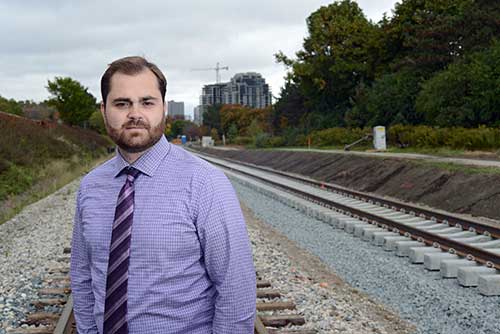
Reid Fulton, principal transit planner for the Region of Waterloo was recently a gifted graduate student working under Casello in the School of Planning. Fulton had his pick of planning jobs when he graduated in 2008, but opted to stay in the Region to work on its pioneering LRT project.
“I know that the Region of Waterloo, going back 10-15 years was very concerned with farmland, protecting sensitive water supply areas and changing pattern of growth,” says Fulton. “The city had grown outwards to the point where it started to compromise on you know our food system and clean water. They made the choice to pursue an agenda of growth management right and LRT came out of that.”
It was a project he was eager to get his hands on since he first started as a student working at Grand River Transit (GRT). While there, Fulton proved so valuable they kept him on part-time while he completed his thesis, and moved some pieces around to give him a full-time contract when he graduated.
In his job, Fulton plans GRT services, bus stops and routes, frequencies, hours as well as designing the transit system terminals and future routes. That last task especially requires detailed information and analysis on how the city is growing.
“There’s absolutely no chance whatsoever, knowing now how my boss is recruiting people, there’s no chance I would have ever gotten in if I hadn’t been in the planning program at UW,” Fulton says of working in an office stacked with Waterloo planners, co-op students and even a handful of international student researchers.
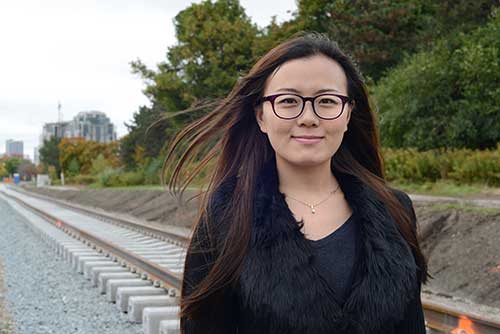
Yu Huang, a skilled researcher from China is one of those international students.
“Currently, we are conducting research on the LRT’s impact on the housing market, including both buyers and sellers, and the rental housing market as well; impacts on developers and investors; impacts on traffic behaviors; and the causal relationship,” she says.
This research project, titled The Central Transit Corridor Monitoring Report, starts with a comprehensive literature review looking at successful and unsuccessful examples of LRT and transit-oriented development and make suggestions to the Region.
The other component uses advanced agent-based modeling, is generating data to better define the impact the LRT will have on the Region and how to shape development strategies to chart a course for optimal development.
Beyond her skills as a number-cruncher, the visiting student also brings vital international experience to the project.
“China is experiencing rapid urbanization since it is still in the process of extensive industry development,” Huang says. “Industrialization brought about so many problems in city centers, like traffic congestion and crowded living conditions, that governments finally directed people to suburban development, which creates new problems.”
As quickly growing cities like Waterloo embark on intense densification, Huang’s insight can help avoid pitfalls, or what Huang calls, “big city disease.”

Read more
Here are the people and events behind some of this year’s most compelling Waterloo stories
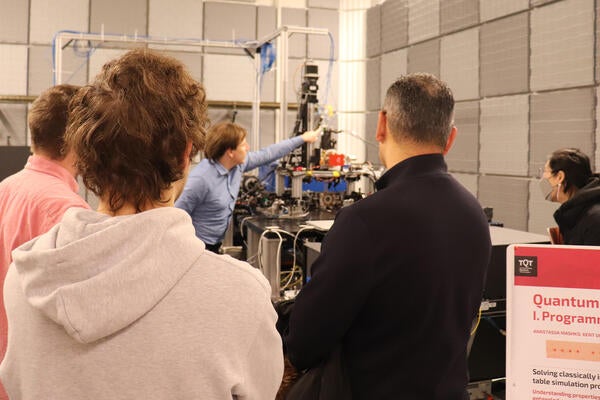
Read more
TQT Quantum Opportunities and Showcase sheds light on quantum research advancements, discoveries and real-world applications
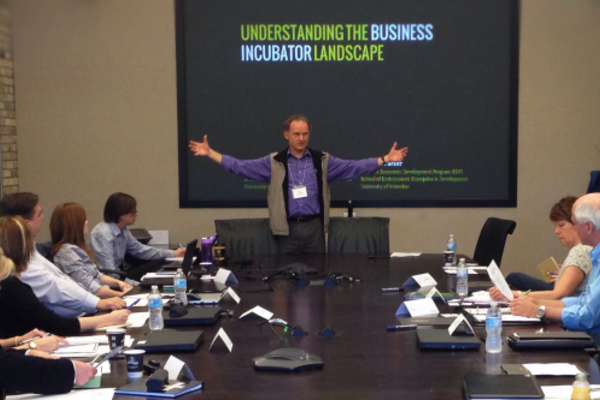
Read more
The partnership creates learning opportunities and delivers training in every province and territory with programs tailored to local needs
The University of Waterloo acknowledges that much of our work takes place on the traditional territory of the Neutral, Anishinaabeg and Haudenosaunee peoples. Our main campus is situated on the Haldimand Tract, the land granted to the Six Nations that includes six miles on each side of the Grand River. Our active work toward reconciliation takes place across our campuses through research, learning, teaching, and community building, and is co-ordinated within the Office of Indigenous Relations.